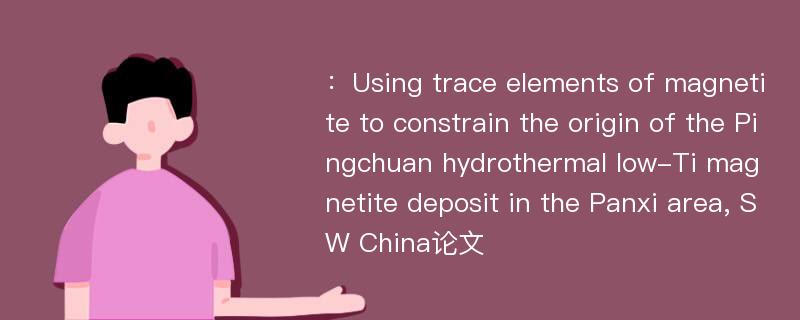
本文主要研究内容
作者(2019)在《Using trace elements of magnetite to constrain the origin of the Pingchuan hydrothermal low-Ti magnetite deposit in the Panxi area, SW China》一文中研究指出:The Pingchuan iron deposit, located in the Yanyuan region of Sichuan Province, SW China, has an ore reserve of 40 Mt with ~60 wt% Fe. Its genesis is still poorly understood. The Pingchuan iron deposit has a paragenetic sequence of an early Fe-oxide–Pyrite stage(Ⅰ) and a late Fe-oxide–pyrrhotite stage(Ⅱ). Stage Ⅰ magnetite grains are generally fragmented, euhedral–subhedral, largesized crystals accompanying with slightly postdated pyrite.Stage Ⅱ magnetite grains are mostly unfragmented, anhedral, relatively small-sized grains that co-exist with pyrrhotite. Combined with micro-textural features and previously-obtained geochronological data, we consider that these two stages of iron mineralization in the Pingchuan deposit correspond to the Permian ELIP magmatism and Cenozoic fault activity event. Both the Stage Ⅰ and Ⅱ magnetites are characterized with overall lower contents of trace elements(including Cr, Ti, V, and Ni) than the ELIP magmatic magnetite, which suggests a hydrothermal origin for them. ‘‘Skarn-like’’ enrichment in Sn, Mn, and Zn in the Stage Ⅰ magnetite grains indicate significant material contributions from carbonate wall-rocks due to water–rock interaction in ore-forming processes. Stage Ⅱ magnetite grains contain higher Mn concentrations than Stage Ⅰ magnetite grains, which possibly implies more contribution from carbonate rocks. In multiple-element diagrams, the Stage Ⅰ magnetite shows systematic similarities to Kiruna-type magnetite rather than those from other types of deposits. Combined with geological features and previous studies on oxygen isotopes, we conclude that hydrothermal fluids have played a key role in the generation of the Pingchuan low-Ti iron deposit.
Abstract
The Pingchuan iron deposit, located in the Yanyuan region of Sichuan Province, SW China, has an ore reserve of 40 Mt with ~60 wt% Fe. Its genesis is still poorly understood. The Pingchuan iron deposit has a paragenetic sequence of an early Fe-oxide–Pyrite stage(Ⅰ) and a late Fe-oxide–pyrrhotite stage(Ⅱ). Stage Ⅰ magnetite grains are generally fragmented, euhedral–subhedral, largesized crystals accompanying with slightly postdated pyrite.Stage Ⅱ magnetite grains are mostly unfragmented, anhedral, relatively small-sized grains that co-exist with pyrrhotite. Combined with micro-textural features and previously-obtained geochronological data, we consider that these two stages of iron mineralization in the Pingchuan deposit correspond to the Permian ELIP magmatism and Cenozoic fault activity event. Both the Stage Ⅰ and Ⅱ magnetites are characterized with overall lower contents of trace elements(including Cr, Ti, V, and Ni) than the ELIP magmatic magnetite, which suggests a hydrothermal origin for them. ‘‘Skarn-like’’ enrichment in Sn, Mn, and Zn in the Stage Ⅰ magnetite grains indicate significant material contributions from carbonate wall-rocks due to water–rock interaction in ore-forming processes. Stage Ⅱ magnetite grains contain higher Mn concentrations than Stage Ⅰ magnetite grains, which possibly implies more contribution from carbonate rocks. In multiple-element diagrams, the Stage Ⅰ magnetite shows systematic similarities to Kiruna-type magnetite rather than those from other types of deposits. Combined with geological features and previous studies on oxygen isotopes, we conclude that hydrothermal fluids have played a key role in the generation of the Pingchuan low-Ti iron deposit.
论文参考文献
论文详细介绍
论文作者分别是来自Acta Geochimica的,发表于刊物Acta Geochimica2019年03期论文,是一篇关于,Acta Geochimica2019年03期论文的文章。本文可供学术参考使用,各位学者可以免费参考阅读下载,文章观点不代表本站观点,资料来自Acta Geochimica2019年03期论文网站,若本站收录的文献无意侵犯了您的著作版权,请联系我们删除。
